the Creative Commons Attribution 4.0 License.
the Creative Commons Attribution 4.0 License.
1H-enhanced 103Rh NMR spectroscopy and relaxometry of 103Rh(acac)3 in solution
Harry Harbor-Collins
Mohamed Sabba
Markus Leutzsch
Recently developed polarisation transfer techniques are applied to the 103Rh nuclear magnetic resonance (NMR) of the 103Rh(acac)3 coordination complex in solution. Four-bond 1H–103Rh J couplings of around 0.39 Hz are exploited to enhance the 103Rh NMR signal and to estimate the 103Rh T1 and T2 relaxation times as a function of field and temperature. The 103Rh longitudinal T1 relaxation in 103Rh(acac)3 is shown to be dominated by the spin–rotation mechanism, with an additional field-dependent contribution from the 103Rh chemical shift anisotropy.
- Article
(2160 KB) - Full-text XML
- BibTeX
- EndNote
Although rhodium is one of the few chemical elements with a 100 % abundant spin- isotope, the routine nuclear magnetic resonance (NMR) of 103Rh has been inhibited by its very small gyromagnetic ratio, which is negative and ∼ 31.59 times less than that of 1H (Mann, 1991).
While indirectly detected 103Rh NMR has had an appreciable history (Crocker et al., 1979; Dykstra et al., 1981; Brevard and Schimpf, 1982; Heaton et al., 1983; Brevard et al., 1981; Herberhold et al., 1999; Ernsting et al., 2004; Carlton, 2008), advances in instrumentation and methodology have allowed rapid observation of 103Rh NMR parameters on standard commercial NMR spectrometers, leading to a recent renaissance of the field (Chan et al., 2020; Bajo et al., 2020; Wiedemair et al., 2021; Widemann et al., 2021; Rösler et al., 2021; Sheng Loong Tan et al., 2021; Caló et al., 2021; Samultsev et al., 2022; Harbor-Collins et al., 2023, 2024; Holmes et al., 2023; Lutz et al., 2023).
The rhodium (III) acetylacetonate (103Rh(acac)3) complex (see Fig. 1) currently serves as the International Union of Pure and Applied Chemistry (IUPAC) 103Rh NMR chemical-shift reference (Carlton, 2008). To the wider scientific community, 103Rh(acac)3 is better known for its role in the production of thin rhodium films and nanocrystals for use in catalysis (Zhang et al., 2007; Aaltonen et al., 2005; Choi et al., 2016).
The early studies of nuclear spin relaxation in 103Rh(acac)3 were greatly limited by the poor 103Rh signal strength, and they provided somewhat conflicting conclusions for the 103Rh relaxation mechanisms (Grüninger et al., 1980; Benn et al., 1985; Maurer et al., 1982). Recently, a two-bond 13C–103Rh coupling of 1.1 Hz was observed in 103Rh(acac)3 and was exploited for triple-resonance experiments (Caló et al., 2021).
We now report the observation of a four-bond 1H–103Rh J coupling of |4JHRh| ≃ 0.39 Hz between the central 103Rh nucleus and each of the three methine 1H nuclei in 103Rh(acac)3 (see Fig. 1). These small couplings are exploited for the 1H-enhanced 103Rh NMR spectroscopy of the 103Rh(acac)3 complex. 103Rh spin–lattice T1 and spin–spin T2 relaxation time constants are measured over a range of magnetic fields and temperatures. The 103Rh T1 relaxation is found to be dominated by spin–rotation, with an additional contribution from the chemical shift anisotropy (CSA), which is significant at high fields.
Experiments were performed on a saturated (∼ 140 mM) solution of rhodium (III) acetylacetonate (103Rh(acac)3) dissolved in 350 µL CDCl3. 103Rh(acac)3 was purchased from Sigma-Aldrich and used as received. 103Rh(acac)3 is a bright yellow powder, which is dissolved in CDCl3 to form a solution with a deep golden colour.
The radio frequency channels were additionally isolated by installing a bandpass (K&L Microwave) and low-pass (Chemagnetics 30 MHz) filter at the preamplifier outputs of the 1H and 103Rh channels, respectively. Pulse powers on the 1H and 103Rh channels were calibrated to give a matched nutation frequency of 2π × 4000 Hz, corresponding to a 90° pulse length of 62.5 µs. Field-cycling experiments were performed using a motorised fast-shuttling system (Zhukov et al., 2018; Harbor-Collins et al., 2023, 2024). The shuttling time was kept constant at 2 s, in both directions.
3.1 1H spectrum
The 1H spectrum for 103Rh(acac)3 in CDCl3 (shown in Fig. 2a) features two resonances: a singlet at 2.170 ppm, corresponding to the six methyl protons on each acac ligand, and a broad, weak doublet centred at 5.511 ppm, corresponding to the acac methine protons. An expanded region showing just the methine resonance is presented in Fig. 2b. The four-bond 103Rh–1H spin–spin coupling is estimated to be |4JHRh| = 0.39 ± 0.01 Hz.
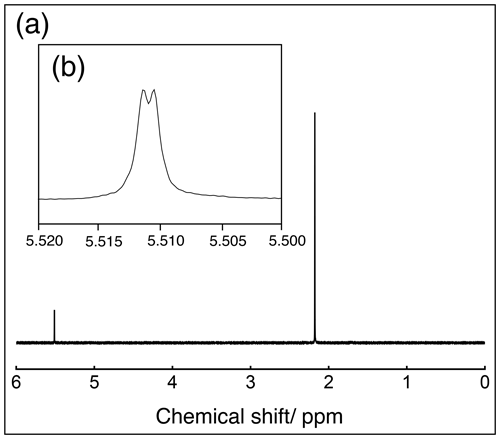
Figure 2(a) 1H spectrum of a ∼ 140 mM solution of 103Rh(acac)3 in CDCl3, acquired at 9.4 T and 298 K, in a single transient. Lorentzian line broadening (1 Hz) was applied. (b) Expanded view of the methine 1H resonance. Negative Lorentzian line broadening (−0.2 Hz) was applied to enhance the resolution.
3.2 103Rh spectra
3.2.1 Direct 103Rh excitation
The 1H-decoupled 103Rh spectrum of the 103Rh(acac)3 solution, acquired with single-pulse excitation of 103Rh transverse magnetisation, is shown in Fig. 3a and displays a single peak with the 103Rh chemical shift of 8337.6 ppm. The signal-to-noise ratio is quite poor, even after 12 h of data acquisition.

Figure 31H-decoupled 103Rh NMR spectra of a ∼ 140 mM solution of 103Rh(acac)3 in CDCl3, in a field of 9.4 T and at a temperature of 295 K. Lorentzian line broadening (1 Hz) was applied to all spectra. 103Rh chemical shifts are referenced to the absolute frequency (Ξ(103Rh) = 3.16 %). In all spectra, 1H decoupling was achieved using continuous wave decoupling with 0.05 W of power, corresponding to a nutation frequency of 1 kHz. (a) 103RhHdec spectrum, acquired using 300 transients, each using a single 103Rh 90° pulse. The waiting interval between transients was 150 s. The total experimental duration was ∼ 12 h. (b) 103RhHdec spectrum, acquired using 16 transients and the pulse sequence shown in Fig. 4, with n=11 repetitions of the DualPol (dual-channel PulsePol) sequence. The waiting interval between transients was 18 s. The total experimental duration was 5 min. (c) 103RhHdec spectrum, acquired using 16 transients and an optimised refocused-INEPT (Insensitive Nucleus Enhancement by Polarisation Transfer) sequence. The waiting interval between transients was 18 s. The total experimental duration was 5 min.
3.2.2 1H–103Rh polarisation transfer by DualPol
Polarization transfer from the 1H nuclei to the 103Rh nuclei was performed using the previously described DualPol pulse sequence incorporating acoustic-ringing suppression (Harbor-Collins et al., 2023), as shown in Fig. 4.
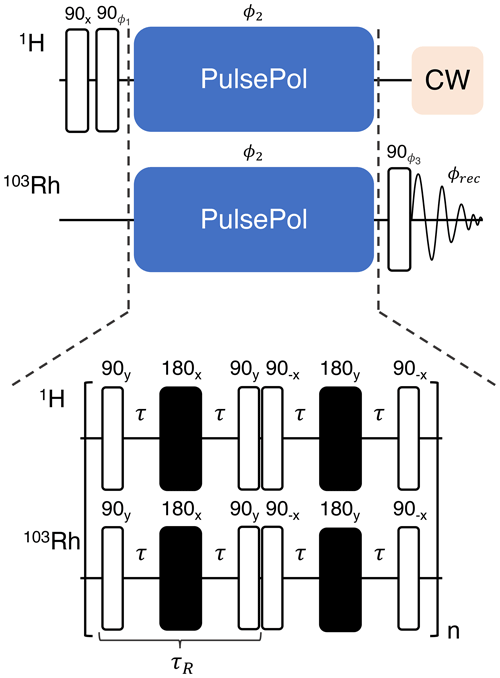
Figure 4Pulse sequence for the acquisition of 1H-enhanced 103Rh spectra; an expanded view of the DualPol pulse sequence module is shown at the bottom. The black rectangles indicate symmetrised BB1 composite 180° pulses (Wimperis, 1994; Cummins et al., 2003) and τ indicates an interpulse delay. Phase cycles are given by the following: , , and the receiver ,.
The DualPol sequence consists of two synchronised PulsePol sequences (Schwartz et al., 2018), applied simultaneously on two radio frequency channels.
The PulsePol sequence was originally developed in the context of electron–nucleus polarisation transfer (Schwartz et al., 2018). As discussed in Sabba et al. (2022), PulsePol may be interpreted as a “riffled” implementation of an R sequence, using the nomenclature of symmetry-based recoupling in solid-state NMR (Carravetta et al., 2000). In the case of PulsePol, the R element is a composite 90y180x90y pulse, with “windows” inserted between the pulses. Furthermore, in the current implementation, the central 180x pulse of each R element is itself substituted by a BB1 composite pulse (Wimperis, 1994). That substitution was previously shown to increase the robustness of the pulse sequence with respect to deviations in the radio frequency amplitudes and resonance offsets (Sabba et al., 2022). The total R-element duration, including all pulses and windows, is denoted using τR here (see Fig. 4).
For the experiments described here, the DualPol sequences used an R-element duration equal to τR = 70 ms, with pulse durations given by τ90 = 62.5 µs for the 90° pulses and τBB1 = 10 × τ90 = 625 µs for the BB1 composite 180° pulses.
The 103Rh and methine 1H nuclei of 103Rh(acac)3 form an I3 S spin system, where the 103Rh nucleus is the S spin and the magnetically equivalent 1H nuclei are the I spins.
The DualPol spin dynamics are identical to those for Hartmann–Hahn J cross-polarisation (Chingas et al., 1981). The DualPol average Hamiltonian has the following form:
where the scaling factor is given by in the limit of short, ideal, radio frequency pulses. In the absence of relaxation and pulse imperfections, a DualPol sequence with a scaling factor , applied to an I3 S spin system should give rise to the following enhancement of the S-spin magnetisation, relative to its thermal-equilibrium value:
Here, T is the overall duration of the DualPol sequence. As the magnetogyric ratios of 103Rh and 1H have opposite signs, the function ϵDualPol(T) is negative for all values of T. The blue curve in Fig. 5 shows a plot of |ϵDualPol| against T, for a J coupling of |JIS| ≃ 0.39 Hz. The maximum value of |ϵDualPol| is given in the absence of relaxation by
for the case of I = 1H and S = 103Rh. As Eq. (2) is quasi-periodic (Chingas et al., 1981), the value of T which maximises |ϵDualPol| is indeterminate. The first maximum may be found numerically and occurs at the duration T1st max ≃ , at which point the theoretical enhancement is given by |ϵDualPol| ≃ ≃ 33.23 for the case of I = 1H and S = 103Rh. Hence, for the estimated 1H–103Rh J coupling of |JIS|≃ 0.39 Hz, assuming , the 103Rh signal enhancement is expected to reach its first maximum at a DualPol duration of T1st max ≃ 1.563 s, in the absence of relaxation.
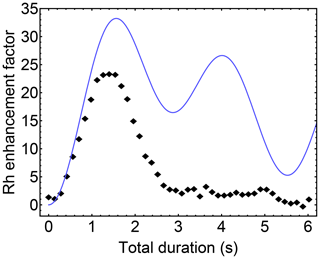
Figure 5103Rh signal enhancement factor for 103Rh(acac)3 as a function of DualPol sequence duration T, normalised against thermal-equilibrium 103Rh polarisation. Black diamonds: experimental data points; solid blue line: the theoretical enhancement factor |ϵDualPol(T)| for an I3 S spin system in the absence of relaxation, as given by Eq. (2) for |JIS| = 0.39 Hz.
In the experiments described here, the optimum duration of the DualPol sequence was found for a repetition number of n=11. For an R-element duration of τR = 70 ms, this corresponds to a total DualPol sequence duration of T = 1.54 s, which is in good agreement with the theoretical value.
The DualPol-enhanced 103Rh spectrum is shown in Fig. 3b and displays an experimental signal enhancement of ∼ 23 over the directly excited 103Rh spectrum in Fig. 3a.
Figure 5 shows the experimental 103Rh signal enhancement factor as a function of the DualPol sequence duration T. Although the maximum of the experimental enhancement occurs at a similar position to the maximum of the theoretical curve, there is clearly a strong damping of the enhancement with respect to the duration T, leading to a loss of intensity at the theoretical maximum. This damping may be associated with transverse relaxation of the 1H and 103Rh transverse magnetisation during the polarisation transfer process.
3.2.3 1H–103Rh polarisation transfer by refocused INEPT
Polarisation transfer from 1H to 103Rh may also be conducted by the standard refocused-INEPT pulse sequence (Burum and Ernst, 1980). In this case, the theoretical enhancement of the S-spin magnetisation, due to transfer from the I spins, is given for the I3 S case, in the absence of relaxation and other imperfections, by Burum and Ernst (1980):
where τ1 and τ2 refer to the total echo durations including two inter-pulse intervals, as shown in Fig. 1 of Burum and Ernst (1980). The maximum of this function is found at and , giving an enhancement of (Doddrell et al., 1981, 1982; Pegg et al., 1981, 1982). Therefore, the maximum theoretical enhancement by refocused INEPT is
for the case of I = 1H and S = 103Rh. Hence, in the absence of relaxation, refocused INEPT can give a slightly greater enhancement than DualPol in an I3 S system. However, the maximum enhancements by both DualPol and INEPT are less than the theoretical bound on the enhancement of S-spin magnetisation by polarisation transfer from the I spins in a permutation-symmetric I3 S spin system, which is equal to (Nielsen et al., 1995).
The theoretical advantage of INEPT over DualPol is not realised in practice for the case of 103Rh(acac)3. The maximum enhancement by refocused INEPT was realised for durations of τ1 = 920 and τ2 = 500 ms, which yielded a 103Rh enhancement factor of ∼ 17 over thermal polarisation, i.e. less than the maximum DualPol enhancement, which was ∼ 23. The experimentally optimised interval τ1 is significantly shorter than the optimum theoretical value in the absence of relaxation, which is = 1.28 s, assuming a 103Rh–1H spin–spin coupling of JHRh = 0.39 Hz. The optimum value of τ2, on the other hand, is very similar to the theoretical value, which is = 503 ms.
The 1H-enhanced 103Rh spectrum, produced by an optimised refocused-INEPT sequence, is shown in Fig. 3c. It shows a significantly lower enhancement than the DualPol result of Fig. 3b, despite the fact that the theoretical enhancement by refocused INEPT is higher than that of DualPol in the absence of relaxation (see Eqs. 3 and 5). The loss of amplitude relative to the theoretical values may be attributed to transverse 1H relaxation during the polarisation transfer process. It is known that Hartmann–Hahn-style cross-polarisation sequences such as DualPol can outperform INEPT in the presence of transverse relaxation (Levitt, 1991).
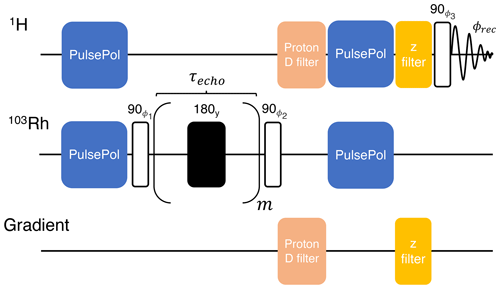
Figure 6Sequence used for the indirect measurement of rhodium T2 through 1H detection. The phase cycles are given by the following: , , and the receiver . The echo interval τecho was 45 ms. The black rectangle indicates a symmetrised BB1 composite 180° pulse (Wimperis, 1994; Cummins et al., 2003). An MLEV-64 supercycle was applied to the phases of the 180° pulses (Levitt et al., 1982a, b; Freeman et al., 1982; Gullion et al., 1990; Gullion, 1993). The 1H “D-filter” and “z-filter” modules are described in Figs. 3 and 4 of Harbor-Collins et al. (2023), respectively.
The 103Rh T2 relaxation time constant for 103Rh(acac)3 in CDCl3 was measured via the methine 1H signals using a variant of a previously described indirectly detected T2 DualPol pulse sequence (Harbor-Collins et al., 2023), which is shown in Fig. 6. The pulse sequence starts with a DualPol sequence of duration T = 1.54 s to transfer thermal-equilibrium longitudinal 1H magnetisation to 103Rh. The 103Rh longitudinal magnetisation is converted into 103Rh transverse magnetisation by a 90° pulse on the 103Rh channel. The 103Rh transverse magnetisation evolves under a Carr–Purcell–Meiboom–Gill (CPMG) train of m spin echoes, each with an echo duration τecho = 45 ms. The Carr–Purcell sequence suppresses the confounding effects of translational diffusion and mixing with antiphase spin operators (Peng et al., 1991). The 103Rh transverse magnetisation is converted to 103Rh longitudinal magnetisation by a second 90° 103Rh pulse. A 1H “D-filter” module is applied to destroy any residual 1H magnetisation, before another DualPol sequence of duration T = 1.54 s transfers the 103Rh longitudinal magnetisation to 1H longitudinal magnetisation. A 1H “z-filter” module is applied to destroy any other 1H magnetisation components, followed by a 90° 1H pulse which excites 1H transverse magnetisation whose precession induces a 1H NMR signal which is detected in the following interval. The 1H D-filter and z-filter modules are described in Figs. 3 and 4 of Harbor-Collins et al. (2023), respectively.
Repetition of the experiment with increasing values of m leads to the 103Rh T2 decay curve shown in Fig. 7. This fits well to a single exponential decay with the time constant T2(103Rh) = 18.36 ± 0.92 s.
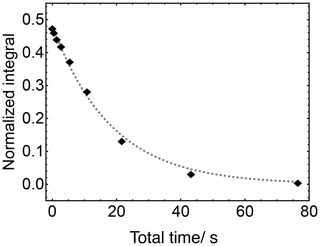
Figure 7Decay curve for the 103Rh transverse magnetisation of 103Rh(acac)3 in solution at a field of 9.4 T, measured by the indirectly detected multiple spin-echo scheme in Fig. 6. The experimental duration was 15 min.
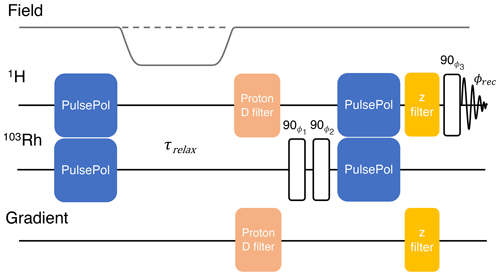
Figure 8Sequence used for the indirect measurement of the rhodium T1 through the 1H NMR signal. Phase cycles are given by the following: , , and the receiver . The optional shuttling of the sample to low field, and back again, during the interval τrelax is indicated. The 1H “D-filter” and “z-filter” modules are described in Figs. 3 and 4 of Harbor-Collins et al. (2023), respectively.
The 103Rh T1 relaxation time constant for 103Rh(acac)3 in CDCl3 was measured indirectly using the methine 1H signals, by means of the pulse sequence shown in Fig. 8 (Harbor-Collins et al., 2023). The pulse sequence starts with a DualPol sequence of duration T = 1.54 s to transfer thermal-equilibrium longitudinal 1H magnetisation to 103Rh. For variable-field experiments, the sample is shuttled out of the high-field magnet into a low-field region. The nuclear magnetisation is allowed to relax for an interval τrelax. If necessary, the sample is shuttled back into high field, and residual 1H magnetisation is destroyed by a 1H D-filter module. A pair of phase-cycled 90° 103Rh pulses are applied to select for 103Rh z-magnetisation before a second DualPol sequence of duration T = 1.54 s transfers the partially relaxed longitudinal 103Rh magnetisation to 1H magnetisation. A 1H z-filter module is applied to destroy any other 1H magnetisation components, followed by a 90° 1H pulse which excites 1H transverse magnetisation whose precession induces a 1H NMR signal that is detected in the following interval. The 1H D-filter and z-filter modules are described in Figs. 3 and 4 of Harbor-Collins et al. (2023), respectively. During τrelax, 1H-enhanced 103Rh magnetisation decays toward thermal 103Rh magnetisation, which is very small; hence, at large values of τrelax, resulting 103Rh-derived 1H signals are very weak and close to zero, even for measurements performed at higher magnetic field strengths.
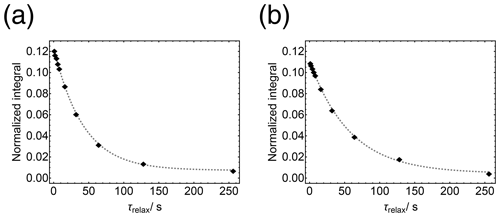
Figure 9Trajectories of longitudinal 103Rh magnetisation for 103Rh(acac)3 in solution at a temperature of 295 K, measured indirectly through the methine 1H signals, using the pulse sequence in Fig. 8. (a) Filled symbols: 1H signal amplitudes at a magnetic field of 9.4 T. The data were acquired in ∼ 2 h. The integrals are normalised against the 1H spectrum obtained by a single 1H 90° pulse applied to a system in thermal equilibrium at 9.4 T and at 295 K. Dotted line: fitted exponential decay with time constant T1(103Rh) = 41.8 ± 0.9 s. Panel (b) is the same as panel (a) but the sample is shuttled to a field of 10 mT during the relaxation delay τrelax. Dotted line: fitted exponential decay with time constant T1(103Rh) = 57.8 ± 1.7 s.
The trajectory of indirectly detected 103Rh z-magnetisation in a field of 9.4 T and at a temperature of 295 K is shown in Fig. 9a. The trajectory fits well to a single exponential decay with time constant T1(103Rh) = 41.8 ± 0.9 s. A trajectory in the low magnetic field of 10 mT and at a temperature of 295 K is shown in Fig. 9b. This was produced by shuttling the sample to a low magnetic field, and back again, during the interval τrelax. The relaxation process is somewhat slower in a low magnetic field, with a time constant of T1(103Rh) = 57.8 ± 1.7 s.
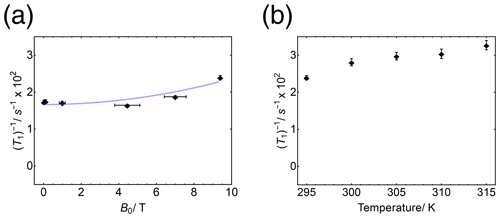
Figure 10(a) 103Rh relaxation rate constant for 103Rh(acac)3 in solution, as a function of magnetic field strength at a temperature of 295 K. The blue line shows the best-fit quadratic function , where = (167 ± 7) × 10−4 s−1 and a = (7 ± 2) × 10−5 . (b) 103Rh relaxation rate constant for 103Rh(acac)3 in solution, as a function of temperature at a magnetic field strength of 9.4 T.
The observed field dependence of the 103Rh relaxation rate constant is shown in Fig. 10a. The magnetic field dependence of is quite weak in this range of fields. The relaxation rate constant increases slightly with increasing magnetic field at the high-field end, suggestive of a weak relaxation contribution from the 103Rh chemical shift anisotropy. The blue curve in Fig. 10a shows the best-fit quadratic function , where = (167 ± 7) × 10−4 s−1 and a = (7 ± 2) × 10−5 .
The observed temperature dependence of the 103Rh relaxation rate constant is shown for a field of B ≃ 9.4 T in Fig. 10b. The rhodium increases monotonically with increasing temperature over the relevant temperature range. At 315 K, relaxation occurs with a time constant of T1(103Rh) = 30.6 ± 1.1 s.
A positive dependence of the 103Rh on temperature was reported previously for 103Rh(acac)3 in solution (Benn et al., 1985).
The temperature dependence of the 103Rh , as shown in Fig. 10b, indicates a dominant spin–rotation relaxation mechanism. For small molecules with a short rotational correlation time relative to the nuclear Larmor period, spin–rotation is the only mechanism that leads to a positive correlation of with temperature (Hubbard, 1963). This is because the amplitudes of the local magnetic fields generated by the spin–rotation interaction are proportional to the root-mean-square rotational angular momentum of the participating molecules – a quantity that is linked to the mean rotational kinetic energy of the molecules, which increases linearly with temperature. For other mechanisms, the decrease in the rotational correlation time τc with increasing temperature leads to a decrease in the relaxation rate with increasing temperature, in the fast-motion limit.
The field dependence of the 103Rh , as shown in Fig. 10a, displays a modest increase in relaxation rate with increasing magnetic field at high field, which suggests an additional contribution from the rotational modulation of the 103Rh CSA tensor. A finite 103Rh CSA tensor is allowed with respect to symmetry under the D3 point group of 103Rh(acac)3 (Buckingham and Malm, 1971). Indeed, solid-state NMR data indicate a 103Rh shielding anisotropy of Δσ ≃ 460 ppm, with relativistic quantum chemistry calculations in reasonable agreement (Holmes et al., 2023). The magnitude of this CSA tensor is modest by 103Rh standards. For example, the 103Rh nuclei in Rh paddlewheel complexes have a shielding anisotropy of |Δσ| ∼ 9900 ppm (Harbor-Collins et al., 2023).
In summary, we have demonstrated the successful transfer of polarisation between the central 103Rh nucleus and the three methine 1H nuclei in 103Rh(acac)3, through the very small four-bond 1H–103Rh couplings. The polarisation transfer is more efficient for DualPol than for refocused INEPT, even though the theoretical efficiency of DualPol is slightly less than that of refocused INEPT, for the relevant I3 S spin system. We have successfully exploited 1H–103Rh polarisation transfer to study the longitudinal and transverse relaxation of 103Rh for 103Rh(acac)3 in solution. The 103Rh T1 relaxation is dominated by the spin–rotation mechanism, with a significant additional contribution from the 103Rh CSA at a high magnetic field.
The software code for the graphics shown in this paper is available from the authors on reasonable request.
The dataset can be accessed at https://doi.org/10.5258/SOTON/D3209 (Harbor-Collins, 2024).
HHC: conceptualisation (equal), data curation (equal), formal analysis (equal), investigation (equal), methodology (equal), software (equal), validation (equal), visualisation (equal), and writing (original draft and review and editing) (equal). MS: conceptualisation (equal), data curation (equal), formal analysis (equal), investigation (equal), methodology (equal), software (equal), visualisation (equal), and writing (original draft and review and editing) (equal). ML: conceptualisation (equal), funding acquisition (equal), investigation (equal), validation (equal), and writing (review and editing) (equal). MHL: conceptualisation (equal), formal analysis (equal), funding acquisition (equal), investigation (equal), project administration (equal), resources (equal), supervision (lead), and writing (original draft and review and editing) (equal).
At least one of the (co-)authors is a member of the editorial board of Magnetic Resonance. The peer-review process was guided by an independent editor, and the authors also have no other competing interests to declare.
Publisher's note: Copernicus Publications remains neutral with regard to jurisdictional claims made in the text, published maps, institutional affiliations, or any other geographical representation in this paper. While Copernicus Publications makes every effort to include appropriate place names, the final responsibility lies with the authors.
This research has been supported by the European Research Council's H2020 programme (grant no. 786707) and the Engineering and Physical Sciences Research Council (grant nos. EP/P009980/1, EP/P030491/1 and EP/V055593/1).
This paper was edited by Patrick Giraudeau and reviewed by two anonymous referees.
Aaltonen, T., Ritala, M., and Leskelä, M.: ALD of Rhodium Thin Films from Rh ( Acac )3 and Oxygen, Electrochem. Solid St., 8, C99, 2005. a
Bajo, S., Alférez, M. G., Alcaide, M. M., López-Serrano, J., and Campos, J.: Metal-Only Lewis Pairs of Rhodium with s, p and d-Block Metals, Chem.-Eur. J., 26, 16833–16845, 2020. a
Benn, R., Brenneke, H., and Reinhardt, R.-D.: 103Rh-NMR Bei 9,4 T – Verbesserter Nachweis Infolge Verkürzter Relaxationszeiten Und Selektivem Polarisationstransfer / 103Rh NMR at 9.4 T – Improved Signal Detection Due to Shortened Relaxation Times and Selective Polarisation Transfer, Z. Naturforsch. B, 40, 1763–1765, 1985. a, b
Brevard, C. and Schimpf, R.: Phosphorus-Irradiation INEPT Experiments on Spin-12 Metal Nuclides. Applications to 103Rh, 183W, and 57Fe, J. Magn. Reson., 47, 528–534, 1982. a
Brevard, C., Van Stein, G. C., and Van Koten, G.: Silver-109 and Rhodium-103 NMR Spectroscopy with Proton Polarization Transfer, J. Am. Chem. Soc., 103, 6746–6748, 1981. a
Buckingham, A. D. and Malm, S. M.: Asymmetry in the Nuclear Magnetic Shielding Tensor, Mol. Phys., 22, 1127–1130, 1971. a
Burum, D. P. and Ernst, R. R.: Net Polarization Transfer via a J-ordered State for Signal Enhancement of Low-Sensitivity Nuclei, J. Magn. Reson., 39, 163–168, 1980. a, b, c
Caló, F. P., Bistoni, G., Auer, A. A., Leutzsch, M., and Fürstner, A.: Triple Resonance Experiments for the Rapid Detection of 103Rh NMR Shifts: A Combined Experimental and Theoretical Study into Dirhodium and Bismuth–Rhodium Paddlewheel Complexes, J. Am. Chem. Soc., 143, 12473–12479, 2021. a, b
Carlton, L.: Chapter 3 - Rhodium-103 NMR, in: Annual Reports on NMR Spectroscopy, vol. 63, edited by: Webb, G. A., Academic Press, https://doi.org/10.1016/S0066-4103(07)63003-8, 49–178, 2008. a, b
Carravetta, M., Edén, M., Zhao, X., Brinkmann, A., and Levitt, M. H.: Symmetry Principles for the Design of Radiofrequency Pulse Sequences in the Nuclear Magnetic Resonance of Rotating Solids, Chem. Phys. Lett., 321, 205–215, 2000. a
Chan, A. P., Parkinson, J. A., Rosair, G. M., and Welch, A. J.: Bis(Phosphine)Hydridorhodacarborane Derivatives of 1,1′-Bis(Ortho-Carborane) and Their Catalysis of Alkene Isomerization and the Hydrosilylation of Acetophenone, Inorg. Chem., 59, 2011–2023, 2020. a
Chingas, G. C., Garroway, A. N., Bertrand, R. D., and Moniz, W. B.: Zero Quantum NMR in the Rotating Frame: J Cross Polarization in AXN Systems, J. Chem. Phys., 74, 127–156, 1981. a, b
Choi, S.-I., Lee, S. R., Ma, C., Oliy, B., Luo, M., Chi, M., and Xia, Y.: Facile Synthesis of Rhodium Icosahedra with Controlled Sizes up to 12 Nm, ChemNanoMat, 2, 61–66, 2016. a
Harbor-Collins, H.: Dataset in support of the paper “H enhanced 103Rh NMR spectroscopy and relaxometry of 103Rhacac in solution”, University of Southampton [data set], 2024. a
Crocker, C., John Errington, R., S. McDonald, W., J. Odell, K., L. Shaw, B., and J. Goodfellow, R.: Rapid Reversible Fission of a C–H Bond in a Metal Complex: X-Ray Crystal Structure of [], J. Chem. Soc. Chem. Commun., 0, 498–499, 1979. a
Cummins, H. K., Llewellyn, G., and Jones, J. A.: Tackling Systematic Errors in Quantum Logic Gates with Composite Rotations, Phys. Rev. A, 67, 042308, 2003. a, b
Doddrell, D. M., Pegg, D. T., Brooks, W., and Bendall, M. R.: Enhancement of Silicon-29 or Tin-119 NMR Signals in the Compounds M(CH3)(n)Cl(4−n)M = Silicon or Tin, n = 4, 3, 2) Using Proton Polarization Transfer. Dependence of the Enhancement on the Number of Scalar Coupled Protons, J. Am. Chem. Soc., 103, 727–728, 1981. a
Doddrell, D. M., Pegg, D. T., and Bendall, M.: Quasi-Stochastic J Cross-Polarization in Liquids, J. Magn. Reson. (1969), 49, 181–196, 1982. a
Dykstra, R. W., Harrison, A. M., and Dombek, B. D.: Multinuclear Nuclear Magnetic Resonance Observations of H-cyclopentadienyldicarbonylrhodium (I) Including Heteronuclear Double and Triple Irradiation, Rev. Sci. Instrum., 52, 1690–1696, 1981. a
Ernsting, J. M., Gaemers, S., and Elsevier, C. J.: 103Rh NMR Spectroscopy and Its Application to Rhodium Chemistry, Magn. Reson. Chem., 42, 721–736, 2004. a
Freeman, R., Frenkiel, T., and Levitt, M. H.: A Simple “Black-Box” Decoupler, J. Magn. Reson. (1969), 50, 345–348, 1982. a
Grüninger, K.-D., Schwenk, A., and Mann, B. E.: Direct Observation of 103Rh NMR and Relaxation Investigations by Steady-State Techniques, J. Magn. Reson., 41, 354–357, 1980. a
Gullion, T.: The Effect of Amplitude Imbalance on Compensated Carr–Purcell Sequences, J. Magn. Reson., Series A, 101, 320–323, 1993. a
Gullion, T., Baker, D. B., and Conradi, M. S.: New, Compensated Carr–Purcell Sequences, J. Magn. Reson. (1969), 89, 479–484, 1990. a
Harbor-Collins, H., Sabba, M., Moustafa, G., Legrady, B., Soundararajan, M., Leutzsch, M., and Levitt, M. H.: The 103Rh NMR Spectroscopy and Relaxometry of the Rhodium Formate Paddlewheel Complex, J. Chem. Phys., 159, 104307, https://doi.org/10.1063/5.0165830, 2023. a, b, c, d, e, f, g, h, i, j
Harbor-Collins, H., Sabba, M., Bengs, C., Moustafa, G., Leutzsch, M., and Levitt, M. H.: NMR Spectroscopy of a 18O-labeled Rhodium Paddlewheel Complex: Isotope Shifts, 103Rh–103Rh Spin–Spin Coupling, and 103Rh Singlet NMR, J. Chem. Phys., 160, 014305, 2024. a, b
Heaton, B. T., Strona, L., Della Pergola, R., L. Vidal, J., and C. Schoening, R.: Multinuclear Variable-Temperature Nuclear Magnetic Resonance Study of Rhodium Carbonyl Clusters Containing Encapsulated Heteroatoms: Ligand and Metal Polyhedral Rearrangements, J. Chem. Soc. Dalton, 0, 1941–1947, 1983. a
Herberhold, M., Daniel, T., Daschner, D., Milius, W., and Wrackmeyer, B.: Mononuclear Half-Sandwich Rhodium Complexes Containing Phenylchalcogenolato Ligands: A Multinuclear (1H, 13C, 31P, 77Se, 103Rh, 125Te) Magnetic Resonance Study, J. Organomet. Chem., 585, 234–240, 1999. a
Holmes, S. T., Schoenzart, J., Philips, A., Kimball, J., Termos, S., R Altenhof, A., Xu, Y., A. O'Keefe, C., Autschbach, J., and Schurko, R.: Structure and Bonding in Rhodium Coordination Compounds: A 103Rh Solid-State NMR and Relativistic DFT Study, Chem. Sci., https://doi.org/10.1039/D3SC06026H, 2023. a, b
Hubbard, P. S.: Theory of Nuclear Magnetic Relaxation by Spin-Rotational Interactions in Liquids, Phys. Rev., 131, 1155–1165, 1963. a
Levitt, M. H.: Heteronuclear Cross Polarization in Liquid-state Nuclear Magnetic Resonance: Mismatch Compensation and Relaxation Behavior, J. Chem. Phys., 94, 30–38, 1991. a
Levitt, M. H., Freeman, R., and Frenkiel, T.: Broadband Heteronuclear Decoupling, J. Magn. Reson. (1969), 47, 328–330, 1982a. a
Levitt, M. H., Freeman, R., and Frenkiel, T.: Supercycles for Broadband Heteronuclear Decoupling, J. Magn. Reson. (1969), 50, 157–160, 1982b. a
Lutz, M. D. R., Zhong, H., Trapp, N., and Morandi, B.: Synthesis and Reversible H2 Activation by Coordinatively Unsaturated Rhodium NHC Complexes, Helv. Chim. Acta, 106, e202200199, https://doi.org/10.1002/hlca.202200199, 2023. a
Mann, B. E.: The Cinderella Nuclei, in: Annual Reports on NMR Spectroscopy, vol. 23, edited by: Webb, G. A., Academic Press, https://doi.org/10.1016/S0066-4103(08)60277-X, 141–207, 1991. a
Maurer, E., Rieker, S., Schollbach, M., Schwenk, A., Egolf, T., and von Philipsborn, W.: Direct Observation of 103Rh-Chemical Shifts in Mono- and Dinuclear Olefin Complexes, Helv. Chim. Acta, 65, 26–45, 1982. a
Nielsen, N., Schulte-Herbrüggen, T., and Sørensen, O.: Bounds on Spin Dynamics Tightened by Permutation Symmetry Application to Coherence Transfer in I2S and I3S Spin Systems, Mol. Phys., 85, 1205–1216, 1995. a
Pegg, D. T., Doddrell, D. M., Brooks, W. M., and Robin Bendall, M.: Proton Polarization Transfer Enhancement for a Nucleus with Arbitrary Spin Quantum Number from n Scalar Coupled Protons for Arbitrary Preparation Times, J. Magn. Reson. (1969), 44, 32–40, 1981. a
Pegg, D. T., Doddrell, D. M., and Bendall, M. R.: Proton-Polarization Transfer Enhancement of a Heteronuclear Spin Multiplet with Preservation of Phase Coherency and Relative Component Intensities, J. Chem. Phys., 77, 2745–2752, 1982. a
Peng, J. W., Thanabal, V., and Wagner, G.: Improved Accuracy of Heteronuclear Transverse Relaxation Time Measurements in Macromolecules. Elimination of Antiphase Contributions, J. Magn. Reson. (1969), 95, 421–427, 1991. a
Rösler, T., Ehmann, K. R., Köhnke, K., Leutzsch, M., Wessel, N., Vorholt, A. J., and Leitner, W.: Reductive Hydroformylation with a Selective and Highly Active Rhodium Amine System, J. Catal., 400, 234–243, 2021. a
Sabba, M., Wili, N., Bengs, C., Whipham, J. W., Brown, L. J., and Levitt, M. H.: Symmetry-Based Singlet–Triplet Excitation in Solution Nuclear Magnetic Resonance, J. Chem. Phys., 157, 134302, 2022. a, b
Samultsev, D. O., Semenov, V. A., and Krivdin, L. B.: Four-Component Relativistic Calculations of NMR Shielding Constants of the Transition Metal Complexes. Part 1: Pentaammines of Cobalt, Rhodium, and Iridium, Magn. Reson. Chem., 60, 463–468, 2022. a
Schwartz, I., Scheuer, J., Tratzmiller, B., Müller, S., Chen, Q., Dhand, I., Wang, Z.-Y., Müller, C., Naydenov, B., Jelezko, F., and Plenio, M. B.: Robust Optical Polarization of Nuclear Spin Baths Using Hamiltonian Engineering of Nitrogen-Vacancy Center Quantum Dynamics, Sci. Adv., 4, https://doi.org/10.1126/sciadv.aat8978, 2018. a, b
Sheng Loong Tan, N., Nealon, G. L., Moggach, S. A., Lynam, J. M., Ogden, M. I., Massi, M., and Lowe, A. B.: (η4-Tetrafluorobenzobarrelene)-η1-((Tri-4-Fluorophenyl)Phosphine))-η1-(2-Phenylphenyl)Rhodium(I): A Catalyst for the Living Polymerization of Phenylacetylenes, Macromolecules, 54, 6191–6203, 2021. a
Widemann, M., Eichele, K., Schubert, H., Sindlinger, C. P., Klenner, S., Pöttgen, R., and Wesemann, L.: Synthesis and Hydrogenation of Heavy Homologues of Rhodium Carbynes: [(Me3P)2(Ph3P)Rh ≡ E-Ar∗] (E = Sn, Pb), Angew. Chem. Int. Ed., 60, 5882–5889, 2021. a
Wiedemair, M., Kopacka, H., Wurst, K., Müller, T., Eichele, K., Vanicek, S., Hohloch, S., and Bildstein, B.: Rhodocenium Functionalization Enabled by Half-Sandwich Capping, Zincke Reaction, Diazoniation and Sandmeyer Chemistry, Eur. J. Inorg. Chem., 2021, 3305–3313, 2021. a
Wimperis, S.: Broadband, Narrowband, and Passband Composite Pulses for Use in Advanced NMR Experiments, J. Magn. Reson., Series A, 109, 221–231, 1994. a, b, c
Zhang, Y., Grass, M. E., Habas, S. E., Tao, F., Zhang, T., Yang, P., and Somorjai, G. A.: One-Step Polyol Synthesis and Langmuir–Blodgett Monolayer Formation of Size-tunable Monodisperse Rhodium Nanocrystals with Catalytically Active (111) Surface Structures, J. Phys. Chem. C, 111, 12243–12253, 2007. a
Zhukov, I. V., S. Kiryutin, A., V. Yurkovskaya, A., A. Grishin, Y., Vieth, H.-M., and L. Ivanov, K.: Field-Cycling NMR Experiments in an Ultra-Wide Magnetic Field Range: Relaxation and Coherent Polarization Transfer, Phys. Chem. Chem. Phys., 20, 12396–12405, 2018. a






